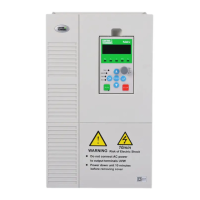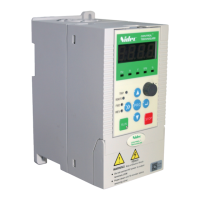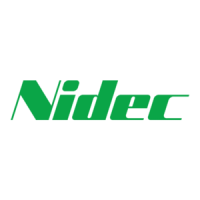What to do if Nidec DC Drives show output phase loss?
- Jjennifer75Sep 8, 2025
If your Nidec DC Drives are showing an output phase loss, check the U-V-W motor wiring. Also, if there is a serious unbalance in output, check the load.

What to do if Nidec DC Drives show output phase loss?
If your Nidec DC Drives are showing an output phase loss, check the U-V-W motor wiring. Also, if there is a serious unbalance in output, check the load.
What to do if Nidec NE200 DC Drives show load short-circuit?
If your Nidec DC Drives are displaying a load short-circuit error, check whether the electric motor coil is short circuit. If the inverting module IGBT is damaged, ask for the services from manufacturers.
What to do if my Nidec NE200 DC Drives show motor overload?
If your Nidec DC Drives indicate a motor overload, several factors could be responsible. First, check the input power source for any abnormalities. Ensure the motor's rated current is correctly configured in the settings. If the V/F curve isn't suitable, adjust it along with the torque boosting performance. For motors consistently operating with heavy loads at low speeds, consider using a specialized electric motor. Also, verify that neither the motor nor the load is blocked or experiencing sudden, large load changes. Finally, if the motor power is insufficient, use a motor and drive with appropriate power ratings.
What causes bus under voltage during running of Nidec NE200?
A bus under voltage during the operation of Nidec DC Drives is caused by power grid low voltage, so check the input power source.
What to do if Nidec NE200 DC Drives show fast current limit fault?
If your Nidec DC Drives are showing a fast current limit fault, it could be due to a load that is too large or a motor blocked to stall, so decrease the load and check the motor and mechanical part status. If the drive power rating is too small, choose a higher power drive. If the drive output circuit loop is grounded or short-circuited, remove the external fault.
What to do if my Nidec DC Drives show over Voltage in Acceleration?
If your Nidec DC Drives display an overvoltage during acceleration, it could be due to a too short acceleration time, so increase it. Another possible cause is an abnormal power supply, so check the input power source.
What to do if my Nidec DC Drives show over voltage in constant speed?
If your Nidec DC Drives are showing an overvoltage at constant speed, first check the input power source for abnormalities. If the load inertia is large, add suitable braking devices.
How to fix heat-sink over heat in Nidec NE200 DC Drives?
To resolve heat-sink overheating in Nidec DC Drives, first lower the ambient temperature. If the fan is damaged, replace it. Also, ensure the fan air duct is clear of any blockages.
What to do if my Nidec DC Drives show over voltage in deceleration?
If your Nidec DC Drives are showing an overvoltage during deceleration, the deceleration time may be too short, so increase it. Also, if the load inertia is large, add suitable brake devices.
What causes over current in Nidec NE200 during deceleration?
Overcurrent during deceleration in Nidec DC Drives can occur due to several reasons. If the deceleration time is too short, increase it. If there is a large load inertia, add suitable brake devices. Finally, if the drive power rating is too small, choose a higher capacity drive.
Explains the drive model number coding and its components.
Details the different NE200 and NE300 product series and their specifications.
Lists key technical specifications for NE200 and NE300 drives.
Provides physical dimensions and outline drawings for product mounting.
Details the physical layout and mounting for the drive's operating keypad.
Describes the dimensions and mounting of the keypad holder.
Guides on selecting and applying appropriate braking resistors for the drive.
Specifies the recommended environmental conditions for installing the drive.
Details proper mounting orientation and necessary clearance for effective cooling.
Provides instructions for removing and reinstalling the keypad and drive enclosure.
Illustrates the overall connection diagram for the drive and peripheral devices.
Explains the function and selection criteria for main circuit peripheral devices.
Offers a guide for selecting and wiring main circuit peripheral devices.
Details the main circuit terminal configurations for various drive models.
Highlights crucial safety and procedural points for main circuit wiring.
Provides wiring diagrams and instructions for the drive's control terminals.
Describes the functions and technical specifications of control circuit terminals.
Presents a schematic diagram of the drive's control board.
Introduces the drive's keypad, its types, and operation.
Details the function of each button on the keypad.
Explains the meaning of various indicators displayed on the keypad.
Describes the four-digit LED display capabilities for status and alarms.
Guides on navigating and modifying the drive's function codes and parameters.
Explains the different display statuses on the keypad.
Details how to set and use the drive's password protection feature.
Describes the functions and configuration of the drive's digital input terminals.
Explains the functions and selection details for the drive's output terminals.
Details the parameters related to the Proportional-Integral-Derivative (PID) control functions.
Covers parameters for Programmable Logic Controller (PLC) and multi-step speed operations.
Details parameters for configuring drive communication settings.
Explains parameters for the drive's operation interface and display settings.
Covers parameters for recording and viewing drive running history and faults.
Describes parameters for the wobble frequency running function.
Explains parameters for the fixed-length control function.
Details parameters for motor overload and other drive protection functions.
Lists parameters related to user password and parameter write-in protection.
Covers fundamental parameters for basic drive functions.
Details parameters for controlling the drive's start and stop operations.
Explains parameters for auxiliary running functions like jog and skip frequencies.
Lists parameters specific to vector control mode for precise motor control.
Details parameters for Voltage/Frequency (V/F) control, suitable for general loads.
Covers parameters for configuring motor characteristics for optimal drive performance.
Provides information on detected faults and their corresponding solutions.
Lists warning codes and their descriptions for the drive.
Offers general guidance for diagnosing and resolving abnormal drive situations.
Outlines routine maintenance procedures and inspection criteria for the drive.
Details periodic inspection requirements for the drive every three to six months.
Provides guidance on replacing vulnerable components like fans and capacitors.
Explains the drive's warranty period and conditions for repair or replacement.
Provides a summary of parameters related to NE300 closed-loop control.
Lists and explains fault codes specific to encoder issues.
Shows a diagram of the NE300 advanced control PCBA.
Illustrates the wiring connections for the control circuit.
Provides instructions for using the CAN non-standard communication protocol.
Briefly describes the functions of various NE300 option cards.
Provides instructions for mounting option cards (PCBA) onto the drive.
Details the installation and specifications for the Resolver PG encoder option.
Explains the installation and specifications for the 5V differential signal PG encoder option.
Details the installation and specifications for the 24V differential signal PG encoder option.











